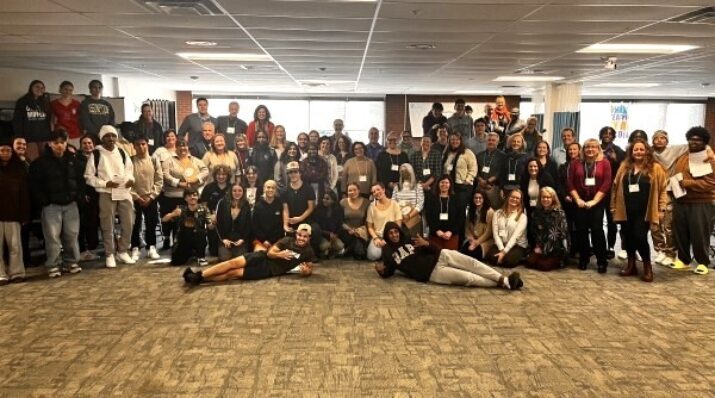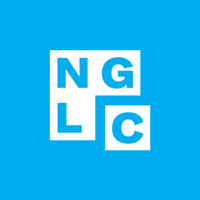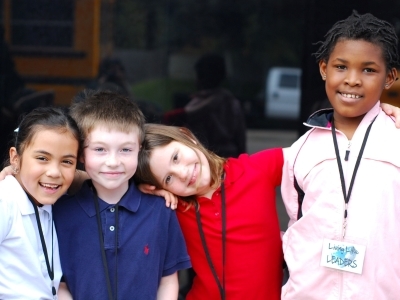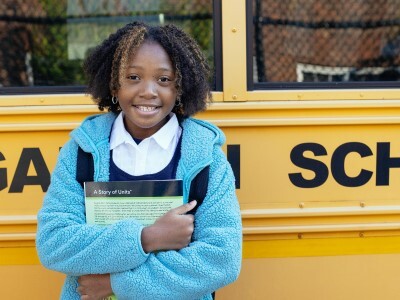Three Stories of Courage and Resilience in the Face of All the Daunting Challenges Happening in Public Education Right Now
Topics

When educators design and create new schools, and live next gen learning themselves, they take the lead in growing next gen learning across the nation. Other educators don’t simply follow and adopt; next gen learning depends on personal and community agency—the will to own the change, fueled by the desire to learn from and with others. Networks and policy play important roles in enabling grassroots approaches to change.
Need a good jolt of optimism as we enter the holidays? These stories of on-going dedication and openness to new thinking and practices—among educators, students, and philanthropists—will brighten your day and perhaps do the same for your outlook.
Public education in the U.S. in 2023 is terribly distressed. Schools, districts, educators, students, and school boards are being battered by an armada of challenges, ranging from post-pandemic trauma and mass-shooting stress among the kids, to the right wing’s malicious and cynical politicization of curriculum and school libraries among far too many policymakers who should know better.
Not to mention that the whole system clings to obsolete, century-old ideas, structures, policies, and practices that generally ignore virtually everything each of us knows, through our own experiences, about how people learn deeply and well.
No wonder so many educators are fleeing. Even the best ones. They have shown so much bravery for so very long. There comes a point when our system and society simply demand too much.
And yet.
Three Stories That Inspire Us
We are realists. We work with educators in their schools and we see what they face. But we also see their determination and resilience. We see them working as hard as they can to build better futures for the students and communities they serve. They inspire us every day.
We want to share three stories that inspire us. We hope that you’ll draw inspiration from them too—and strive to see, and celebrate, and learn from, and build upon the inspiring stories that continue to unfold, despite all of the challenges, in your own work with communities, schools, educators, and kids.
When Humans, Not Systems, Run Schools
Andy Calkins
I wrote an article with that title three years ago, during the heart of the pandemic. This story takes on deeper meaning since the release of ChatGPT and other forms of generative AI. Learning to become a high-functioning human being is an intensely personal, human act. We can’t simply plug ourselves into an AI-driven system and get smart. Just about everything that young people (and adults) experience in public schools, though, is relentlessly shaped by inhumane systems. Many of those systems—let’s name test-based accountability as an example—compel educators and students into behaviors and mindsets (“Will this be on the test?”) that do not in any way reflect the deep, powerful, enduring, joyful, intensely personal learning that human beings are born loving to do.
Like the educators I wrote about in that 2020 article, teachers and administrators NGLC is lucky enough to work with today are finding ways to act humanely in the face of all the systems that govern what goes on in schools. Seven of them are principals in Vista Unified School District, just north of San Diego, California. Jenny Chien, Greg Giroux, David Jaffe, Erik Korporaal, David Post, Kyle Ruggles, Andrew Walanski: These are the school leaders NGLC currently partners with through our Bravely initiative—literally, the art and science of catalyzing (not simply managing) change in schools, in ways that deeply embody the human-development goals of 21st-century public education. This is an act of bravery because this form of leadership relies on inclusiveness, trust, and the distribution of agency across all levels in a school’s hierarchy, rather than on directives. It is power with, not power over.
What does this look like in practice? In Kyle Ruggles’ case, it means inviting staff at Alamosa Park Elementary School to envision all the ways their school can genuinely unite around shared purposes and strategies, across the lines that sometimes seem to separate it into two factions. One faction is the “regular” Alamosa Park and the other is its relatively new Dual Language Immersion program, in which students start out learning 90% of their skills and content in Spanish, moving to 50/50 by grade 5. Kyle got a flood of great ideas in response to his invitation and the Alamosa Park team is giving many of them a try this year. Kyle is engaging the school faculty in conversations about the most engaging, immersive, powerful learning activities that the Alamosa Park kids are experiencing in both kinds of classrooms—and how the working culture of the adults can reflect that same sense of excitement, purpose, and connection.
Leading in this way puts the best work happening in the school right in the center. Just as important, it puts Kyle in the position of learner, along with everyone else.
These are hallmarks of the change-catalyzing methodology that NGLC has distilled from five years of studying a remarkable group of resilient school districts deeply committed to transforming learning and student outcomes. We call it liberatory transformation design. This research has been supported throughout that period by the Carnegie Corporation of New York, which just this past month awarded NGLC a new $1.15 million grant to further advance this important work. That degree of consistent, steadfast philanthropic support—during a time of shifting priorities among major education-focused foundations—reflects a strong measure of organizational coherence and brave, abiding commitment, for which we are forever grateful. Philanthropies, along with educators, can demonstrate courage and resilience, too.
Courage, Bravery, and the School’s Role
Carlos Beato
When adults model the practices embedded in liberatory transformation design, students begin to experience school in different ways and can begin to imagine possibilities they never thought could be a reality for them. Consider the stories from three students who NGLC nominated to the coveted Posse Foundation Leadership scholarship and made it to the finalist round: Marilyn, Rosa, and José. These are three students who are willing to leave everything behind to follow their dreams. These are stories of courage, hope, and resilience and how their surroundings, including their school environments, have motivated them to forge a path forward that is different from any of their family members’ lived experiences.
Marilyn is a senior at International High School at Langley Park in Maryland, a school where I was founding principal from 2014 to 2021. The school is grounded on a competency-based model and serves 100 percent current and former English learners. Learn more about IHSLP’s learner-centered systems and how students are prepared to be their best future selves. Both José and Rosa are seniors at Alliance Marine - Innovation & Technology 6-12 Complex in Los Angeles. Alliance MIT is led by founding principal Jonathan Tiongco, a former NGLC grantee and visionary leader who continues to strive to implement innovative strategies that successfully prepare students for life after high school. You can learn more about the charter network’s blended learning model in this NGLC article centered on distributive leadership.
I asked them four questions as they navigate this journey: 1) What inspires or motivates you? 2) How do you define being brave/courageous? 3) What would winning the Posse scholarship mean to you? What impact might this have for you? and4) How has your current school prepared you for what happens after high school?
Marilyn talked about IHSLP as a place that has prepared her for life after high school. She states “IHSLP has prepared me for life after high school by showing me the value of treating everyone equally and to appreciate the differences within us all. The school has also prepared me to use academic strategies well, like using writing formulas correctly, and many other strategies that other schools might not show to current and former English learners, like me. Therefore, I feel prepared for college no matter what college I end up attending.” Culturally responsive spaces that challenge students academically are an important component of successful next gen learning schools that take student personal backgrounds into consideration to develop personalized approaches for students.
For Rosa, her personal identity is a key factor in her decision to attend college and speaks to the importance of school nurturing student curiosity. She states: “my identity and the lack of representation in certain work fields motivates me to persevere and work hard. I am Peruvian American, a first generation Latina in the United States. Growing up, the only TV series I remember including a Hispanic character was Dora. Although I didn’t really care about what color the person on TV was at the time, I realized if there were to be a TV series about high paying and “respected” jobs, the only Hispanic person I would see would be the janitor. As the daughter of a janitor and mechanic, I respect the amount of labor and hours they have to put in. However, I want to be an educated Latina on screen with the respected title and job. I want to bring diversity to work forces and inspire other Latinos to become educated as well.”
Building on that, José speaks about the importance of having the opportunity to be exposed to challenging coursework at Alliance MIT and feeling safe enough that he can take ten out of the twelve AP courses offered at his school. José said this about Alliance MIT: “My high school has done everything in its capability to prepare me for college. It has provided me with all the opportunities and resources that have given me an upper hand in my search for a college. It has also, simultaneously, been there for me mentally with amazing counselors who understand my needs and my worries.” As we do in the classroom via instruction in next gen schools, we must also ensure that the support first generation college students receive is personalized so that they can successfully navigate this process. The college application process is about more than just applying for college; that is only a fraction of the process and schools must be equipped with the appropriate personnel and staff to support students from all backgrounds to make the best choices for their futures.
If there is one word that I would use to describe these three students it would undoubtedly be BRAVE. Each of them is embarking on a journey of exploration that is foreign to them. José was a finalist for University of Wisconsin-Madison in Wisconsin, which is 1,982 miles away from Alliance - MIT. Rosa was a finalist for Middlebury College, my alma mater in Vermont, which is 2,939 miles away from Alliance - MIT. Marilyn was a finalist for Lewis & Clark College in Oregon, more than 2,800 miles from IHSLP. I was curious to know how each of them defines what bravery means to them in the context of making it this far in the Posse scholarship process and here’s what each of them said:
- José - “I define being brave as willing to be out of your comfort zone. Taking calculated risks that are meant to make you a better person. It also means being there for others even if you aren't necessarily comfortable. In the end it's the effort that makes you brave.”
- Marilyn - “Being brave is a privilege as not all people have the ability to be brave. Someone that is brave will always fight for her/his family as well as for their dreams. Also never fearing the obstacles they might encounter along the way.”
- Rosa - “Being brave means not letting your fear limit you. It’s easy to be afraid of things. As the scaredy-cat sister, I’m well acquainted with the feeling. Pushing past my fear opened many opportunities and allowed me to experience amazing moments I never would have tried if I had continued to limit myself.”
Schools across the nation are filled with Marilyns, Rosas, and Joses that are longing to be challenged, to be pushed beyond their boundaries, to be inspired to be their bravest self. These students are the future of our nation and I, for one, feel extremely excited about what’s to come if at this young age they are already demonstrating wisdom of this caliber. We all have something to learn from the kids in our schools. I challenge school educators and support staff to be inspired by talking to their students about what they want out of life. You might be surprised, in a good way.
Bravery Is Contagious
Kristen Vogt
When adults model the practices embedded in liberatory transformation design, and when students experience school in different ways, others take notice. We saw this on a recent NGLC Innovative Schools Learning Excursion featuring Casco Bay High School (CBHS) in Portland, Maine.
Together with the Barr Foundation, NGLC invited high school teams from across New England to visit this expeditionary learning school that’s one of Portland Public Schools’ three high schools. We had room for about 5 teams of educators but 14 teams submitted thoughtful and compelling applications. Graciously, our partners at CBHS opened their school up for three visits this year instead of just one so we could accommodate all 14 teams (that’s 96 educators) in their 400-student school. The last of those visits was in November, with one team coming from Burlington in Vermont and five teams from Massachusetts: Auburn, Berkshire Educational Resources K-12 (a regional collaborative of 4 districts), Manchester-Essex Regional High School, and Monument Mountain Regional High School.
The teams of school leaders, teachers, counselors, instructional technologists, and others went on learning walks to observe learning throughout Casco Bay High School, joined a crew meeting (crew is a type of advisory), asked questions and exchanged practice ideas through panels and informal conversations over meals, and joined four workshops facilitated by CBHS faculty. The workshops went deeper into practice around proficiency-based grading, expeditions and project-based learning, intensives, and crew. We each also had a chance to hear about seniors’ “Changemaker’s Challenge” and, in small groups of two students with one visiting educator, each of the visitors followed a protocol to give feedback on the two seniors’ “Slice of the Solution” ideas. Many participating educators told us that the time with CBHS students, in meaningful dialogue like this session provided, was the most valuable opportunity of the whole program.
When we talk about learning excursions at NGLC, we often say “seeing is believing.” Casco Bay’s instructional practices, learning design, and systems of support are great examples of innovative practices that make a difference for students that participants were able to see. But the most important thing that educators “saw” at CBHS that really makes them “believe” might actually be the school’s deeply embedded sense of identity, culture, and community. This is a school where the vision and mission is so clear, not because it’s clearly articulated on a plaque by the front door or in a strategic plan, but because it is so present and felt in every interaction, every piece of student work displayed on the walls, every decision made about the schedule, the structures in place for the student support team, the overall learning experience, the school traditions, and the people. The school culture is so clear that every participant who visited could see it. And that’s what they are taking home with them.
Each team left the Innovative Schools Learning Excursion with actions to try and ideas to share with their colleagues at home. Take for example the Burlington School District team: “We are really thinking about the ways in which students can learn from other students about how to be successful. We were really inspired by the Casco Bay rituals in this area. Our focus is thinking about how we can foster a connection between 11th and 8th graders (that will then transfer to Frosh/Senior year) and between 7th graders and 5th graders. One hope is to try a ‘student step-up’ day this spring between 11th and 8th graders. Two of our high school teachers will be bringing this to the high school leadership team.” Another team told us, “We've been talking with our principal about the intensive model as a way to expand our academic offerings, energize/inspire staff and students, and serve as a more trauma-informed and joyful way of achieving credit recovery.”
Educators closed out their time at CBHS by describing a shift in their mindset, in the form of “I used to… but now I…” Here are a few of the shifts that educators shared in this closing activity facilitated by CBHS principal Derek Pierce.
- “I used to think high quality instruction had to drive everything in education, and now I really think that the positive culture piece is what drives the high quality instruction.”
- “I used to think crew was a part of our day and I now realize it's essential to our community. And so we have some structures in place now to get there, and I'm inspired to go wherever we need to go.”
- “I used to think that observing and seeing cohesion within a school would be really hard to witness as well as replicate. But now I see that here it's possible. It's not perfect, but it's done in a really authentic way that feels really wonderful.”
- “I used to be very resistant to the idea of standards-based grading because I couldn't see how it would work. And I now have had my eyes open to—even if I can't completely make the transformation—how I can make small changes in what I currently do to move in that direction.”
It’s pretty amazing what happens when we bring people together to explore what’s possible in public education, isn’t it? As one educator said in that closing activity, “I used to be uninspired... Now I am re-energized.” The ripple effect is in play here, so that it’s not just the individuals who came together in November who benefit. This experience has the potential to reach beyond them. Through relationships and ongoing conversations, their renewed determination and resilience becomes contagious, and that will lead to their schools building better futures for the students and communities they serve.
Fortunately, the ripples will continue. We are excited to announce the 18 teams that have been selected to participate in two Innovative Schools Learning Excursions this spring. One will feature Manchester High School in Manchester, Connecticut, and the other will bring educators to visit three high schools in Vermont—Harwood Union, Twinfield, and Winooski. These excursions will explore students’ stories of learning and youth-adult partnership, within innovative models of personalized, competency-based learning, academies, and flexible pathways. This time, it’s not just educators who will be participating. Each team includes students, and we will also have parents, school board members, and community partners joining the teachers and school and district staff. All of these partners will have their own chance to see, and believe, and take the steps they need to for their communities.
Congratulations to the brave teams that have received small grants, through funding provided by the Barr Foundation, to support their participation.
Learning Excursion to Manchester, CT
Chelsea Public Schools, MA
Franklin Schools, NH
Hope High School, RI
Holyoke High School North Campus, MA
LightHouse Holyoke, MA
Lowell High School, MA
Portland Public Schools, ME
Taunton High School, MA
Learning Excursion to Vermont
Barnstable Public Schools, MA
Berkshire Arts & Technology Charter Public School (BART), MA
Berkshire Hills Regional School District, MA
Blackstone Millville Regional High School, MA
Boston International Newcomers Academy (BINcA), MA
Farmington High School, NH
Gateway Regional School District, MA
Lowell Career Academy, MA
Mohawk Trail Regional High School, MA
Pioneer Valley Regional School District, MA
Here’s to the school and district leaders, teachers, students, board members, parents and community partners who declare, in joining trips like these, that they want to learn, actively and deeply, from peer communities that have done brave work. And here’s to all of you—readers of these articles by and about next gen learning trailblazers—for declaring your own commitment to learning, as well. You inspire us, each and every day. Your commitment is the reason we at NGLC do the work we do, and why we continue to have hope that the best days for public education in the United States are ahead of us.
Photo at top: NGLC Learning Excursion participants with Casco Bay High School learners. Credit: Elizabeth Hampton, Casco Bay High School




